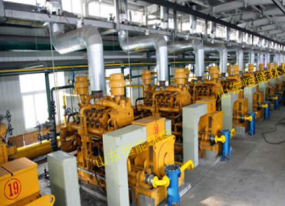歡迎進入山東恒能環保能源設備有限公司
歡迎進入山東恒能環保能源設備有限公司
1、除霧器效率不高
1. The efficiency of demister is not high
除霧器是濕法脫硫裝置中關鍵設備之一,它的作用就是收集經噴嘴霧化后的液滴,減少煙氣帶水,降低經洗滌凈化后的煙氣所夾帶的液滴量,所以若除霧效率不高就會形成煙氣帶水。除霧器的除霧效果優劣對煙氣中夾帶的水量有密切的關系。特別是在吸收塔內煙氣流場不均、煙氣流速過快時,以及在除霧器效率降低時,除霧器無法有效地除去煙氣中攜帶的液滴,并造成已捕集霧滴的二次夾帶,凈煙氣中留存的石膏漿液或液滴會更多。濕法脫硫系統在運行過程中,雖然除霧器可除去大部分液滴,但還是有小部分液滴隨煙氣排出間。由于除霧器不能完全除去漿液液滴,這就導致凈煙氣中必然含有一定量的漿液液滴。凈煙氣中的這些石膏漿液和液態水是形成煙氣帶水的根本原因。所以除霧器效率是形成煙氣帶水的主要原因。
Demister is one of the key equipment in the wet desulfurization device. Its function is to collect the droplets atomized by the nozzle, reduce the water entrained in the flue gas and reduce the amount of droplets entrained in the flue gas after washing and purification. Therefore, if the demisting efficiency is not high, the water entrained in the flue gas will be formed. The defogging effect of the demister is closely related to the amount of water entrained in the flue gas. Especially when the flue gas flow field in the absorption tower is uneven, the flue gas flow rate is too fast, and the efficiency of the demister is reduced, the demister cannot effectively remove the droplets carried in the flue gas, resulting in the secondary entrainment of the captured droplets, and more gypsum slurry or droplets will be retained in the net flue gas. During the operation of the wet desulfurization system, although the demister can remove most of the droplets, there are still a small number of droplets discharged from the room with the flue gas. Since the demister cannot completely remove the slurry droplets, a certain amount of slurry droplets must be contained in the net flue gas. The gypsum slurry and liquid water in the clean flue gas are the fundamental reasons for the formation of water in the flue gas. Therefore, the efficiency of demister is the main reason for the formation of flue gas with water.
2、煙氣溫度過低
2. Flue gas temperature is too low
脫硫催化劑
Desulfurization catalyst
進入吸收塔前,煙氣溫度為100-130℃。取消了煙氣換熱器以后,煙囪排煙溫度比較低,所以經過濕法煙氣脫硫后,吸收塔出口的凈煙氣溫度一般為45-55℃。煙氣在通過煙囪的過程中,煙溫不斷下降。當濕煙氣溫度降到飽和溫度以下時,煙氣中的飽和態水遇到冷壁面而冷凝,并與石膏漿液迅速凝結形成雨滴。當雨滴所受重力大于煙氣浮力時,便往下沉降甚至降落在煙囪出口。特別是在陰霾天或氣溫、氣壓較低時,凈煙氣中攜帶的石膏漿液液滴便沉降在煙囪附近。所以,煙氣溫度和所處的濕飽和狀態是形成煙氣帶水現象的原因之一。

Before entering the absorption tower, the flue gas temperature is 100-130 ℃. After canceling the flue gas heat exchanger, the flue gas temperature of the chimney is relatively low, so after wet flue gas desulfurization, the net flue gas temperature at the outlet of the absorption tower is generally 45-55 ℃. In the process of flue gas passing through the chimney, the flue gas temperature decreases continuously. When the wet flue gas temperature drops below the saturation temperature, the saturated water in the flue gas condenses when it meets the cold wall, and quickly condenses with gypsum slurry to form raindrops. When the gravity of raindrops is greater than the buoyancy of flue gas, they will settle down and even fall at the outlet of chimney. Especially in cloudy days or when the temperature and air pressure are low, the gypsum slurry droplets carried in the net flue gas will settle near the chimney. Therefore, the flue gas temperature and the wet saturation state are one of the reasons for the formation of water entrainment in flue gas.
3、煙囪結構不合理
3. Unreasonable chimney structure
煙囪結構不合理也是造成煙氣帶水的原因之一。取消煙氣換熱器裝置后,煙氣中就會攜帶大量冷凝水。在煙氣流經煙囪的過程中,煙囪內壁上會產生凝結水,部分凝結水被煙氣帶出排入大氣,即形成煙氣帶水現象。煙囪設計不合理造成煙氣帶水,主要體現在煙囪的形狀;煙囪內壁的平整度;煙囪出口直徑這三方面。
Unreasonable chimney structure is also one of the reasons for water entrainment in flue gas. After canceling the flue gas heat exchanger, a large amount of condensate will be carried in the flue gas. In the process of flue gas flowing through the chimney, condensate will be generated on the inner wall of the chimney, and part of the condensate will be carried out by the flue gas and discharged into the atmosphere, that is, the phenomenon of flue gas carrying water will be formed. The unreasonable shape of chimney is mainly caused by the unreasonable design of chimney water; Flatness of inner wall of chimney; Chimney outlet diameter.
4、環境氣象條件
4. Environmental meteorological conditions
環境氣象條件主要指環境溫度、相對濕度和大氣壓力,這是形成煙氣帶水現象的外部原因。
Environmental meteorological conditions mainly refer to ambient temperature, relative humidity and atmospheric pressure, which is the external reason for the formation of water entrainment in flue gas.
(1)環境溫度。在脫硫后煙氣從煙囪排出時,如果環境溫度與煙氣溫度相差較大,煙氣不能及時擴散,飽和態水遇冷就會變成過飽和狀態,與煙氣中其他成分一起凝結而沉降,形成煙氣帶水。
(1) Ambient temperature. When the flue gas is discharged from the chimney after desulfurization, if there is a large difference between the ambient temperature and the flue gas temperature, the flue gas cannot diffuse in time, and the saturated water will become supersaturated when it is cold, which will condense and settle with other components in the flue gas to form flue gas with water.
(2)相對濕度。環境相對濕度的大小反映了環境空氣的飽和程度。相對濕度越大,空氣越接近飽和狀態。因此相對濕度越大的地區,越易形成煙氣帶水現象。
(2) Relative humidity. The relative humidity of the environment reflects the saturation degree of the ambient air. The higher the relative humidity, the closer the air is to saturation. Therefore, the greater the relative humidity, the easier it is to form the phenomenon of flue gas with water.
(3)大氣壓力。環境大氣壓力越低,煙氣越不容易擴散,越易形成煙氣帶水現象。
(3) Atmospheric pressure. The lower the ambient atmospheric pressure is, the less likely the flue gas is to diffuse and the more likely it is to form the phenomenon of flue gas with water.
以上就是今天帶給大家的知識沼氣脫硫專注行業多年,為用戶不斷的提供有價值的內容,更多內容請繼續關注我們:http://lbflj.com
The above is the knowledge brought to you today. Biogas desulfurization has focused on the industry for many years and continuously provided users with valuable content. Please continue to pay attention to us for more content: http://lbflj.com